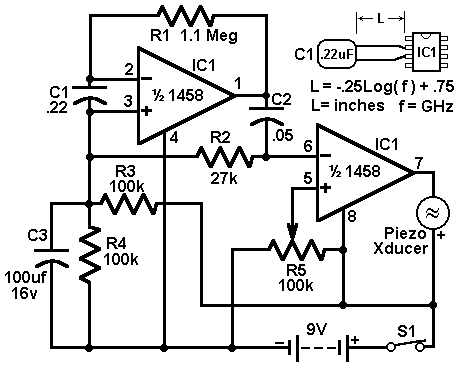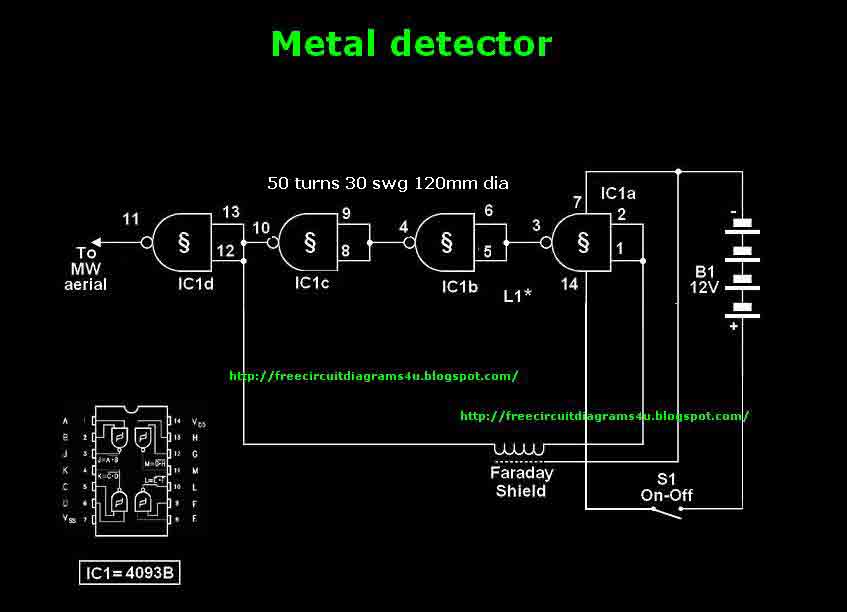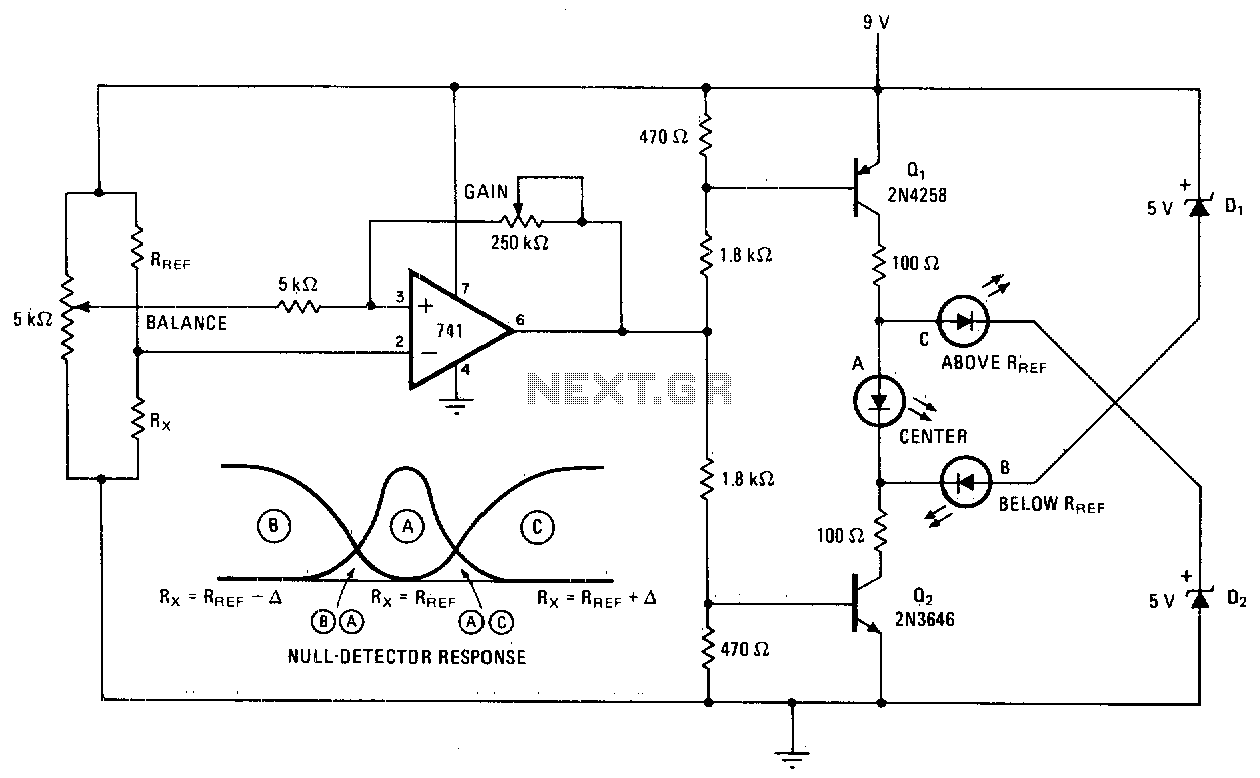
Economy radar detector

This circuit employs a 1458 dual op-amp to create a radar detector. C1 acts as the radar signal detector. The first op-amp functions as a current-to-voltage converter, while the second op-amp buffers the output to drive the piezo transducer. R5 establishes the switching threshold of the second op-amp; it is typically adjusted to ensure that the circuit only triggers on background noise, and then slightly reduced. The circuit's response can be fine-tuned by modifying the length of the leads on C1. For standard road-radar systems, the input capacitor's leads should measure approximately 0.5 to 0.6 inches in length.
The radar detector circuit utilizing the 1458 dual op-amp is designed for efficient detection of radar signals. The circuit's architecture consists of two operational amplifiers (op-amps) integrated within the 1458 IC. The first op-amp is configured as a current-to-voltage converter, which transforms the incoming radar signal detected by capacitor C1 into a proportional voltage. This conversion is critical for accurately interpreting the radar signal strength.
The second op-amp serves as a buffer, providing isolation between the signal processing stage and the output stage, which drives the piezo transducer. This buffering action ensures that the output signal maintains integrity and does not affect the performance of the first op-amp. The piezo transducer converts the electrical signal into an audible sound, alerting users to the presence of radar signals.
Resistor R5 plays a vital role in determining the sensitivity of the circuit. By adjusting R5, the user can set the threshold at which the second op-amp activates. This threshold is typically calibrated to respond only to significant radar signals, minimizing false positives from background noise. The initial setting is usually at a point where the circuit just starts to trigger on background noise, followed by a slight reduction to ensure reliable operation.
The performance of the radar detector can also be optimized by adjusting the lead lengths of capacitor C1. The specified lead length of 0.5 to 0.6 inches is crucial for achieving the desired frequency response and sensitivity. Longer or shorter leads may alter the circuit's performance, potentially leading to unintended results.
Overall, this radar detector circuit is a practical application of operational amplifiers in signal processing, providing an effective solution for detecting radar signals in various environments. Proper calibration of component values and lead lengths is essential for maximizing the performance and reliability of the detector.This circuit uses a 1458 dual op-amp to form a radar detector. C1 is the detector of the radar signal. The first op-amp forms a current-to-voltage converter and the second op-amp buffers the output to drive the piezo transducer. R5 sets the switching threshold of the second op-amp; normally it is adjusted so that the circuit barely triggers on bac
kground noise, then it`s backed off a bit. The response of the circuit may be tuned by adjusting the length of the leads on C1. For typical road-radar systems, the input capacitor`s leads should be about 0. 5 to 0. 6 inches long. 🔗 External reference
The radar detector circuit utilizing the 1458 dual op-amp is designed for efficient detection of radar signals. The circuit's architecture consists of two operational amplifiers (op-amps) integrated within the 1458 IC. The first op-amp is configured as a current-to-voltage converter, which transforms the incoming radar signal detected by capacitor C1 into a proportional voltage. This conversion is critical for accurately interpreting the radar signal strength.
The second op-amp serves as a buffer, providing isolation between the signal processing stage and the output stage, which drives the piezo transducer. This buffering action ensures that the output signal maintains integrity and does not affect the performance of the first op-amp. The piezo transducer converts the electrical signal into an audible sound, alerting users to the presence of radar signals.
Resistor R5 plays a vital role in determining the sensitivity of the circuit. By adjusting R5, the user can set the threshold at which the second op-amp activates. This threshold is typically calibrated to respond only to significant radar signals, minimizing false positives from background noise. The initial setting is usually at a point where the circuit just starts to trigger on background noise, followed by a slight reduction to ensure reliable operation.
The performance of the radar detector can also be optimized by adjusting the lead lengths of capacitor C1. The specified lead length of 0.5 to 0.6 inches is crucial for achieving the desired frequency response and sensitivity. Longer or shorter leads may alter the circuit's performance, potentially leading to unintended results.
Overall, this radar detector circuit is a practical application of operational amplifiers in signal processing, providing an effective solution for detecting radar signals in various environments. Proper calibration of component values and lead lengths is essential for maximizing the performance and reliability of the detector.This circuit uses a 1458 dual op-amp to form a radar detector. C1 is the detector of the radar signal. The first op-amp forms a current-to-voltage converter and the second op-amp buffers the output to drive the piezo transducer. R5 sets the switching threshold of the second op-amp; normally it is adjusted so that the circuit barely triggers on bac
kground noise, then it`s backed off a bit. The response of the circuit may be tuned by adjusting the length of the leads on C1. For typical road-radar systems, the input capacitor`s leads should be about 0. 5 to 0. 6 inches long. 🔗 External reference





